| ACCESS CONTROL SYSTEMS | | DOOR ENTRY SYSTEMS |
| • | Access control can be achieved with or without the intervention of a person |
| • | Selecting those with authority to enter specific doors |
| • | Protecting staff & property |
| • | Single door standalone units to multi-site networks |
| • | External or internal doors / barriers |
| • | Different levels of authority during specific time-bands |
| • | Pin code, swipe, proximity or biometric readers |
| • | We comply with the NSI code of practice and BS EN 50133 |
|
|
| • | Closing the door on crime |
| • | Including Residential blocks of flats, Care Homes, Commercial Premises |
| • | Communicate to your entrance before opening the door |
| • | Speak from a safe distance and save time for you or your staff |
| • | Audio Entry or Video Entry |
| • | DDA compliant Entry Panels |
|

|
|
| When the system comprises a door panel with a call button or a number of call buttons and a handset at the receiving end for a person to interrogate a visitor, this type of system is known as a door entry system. |
| Door Entry can be very simple using an entry panel at the external side of the door to be controlled and a telephone handset at a location within the premises convenient to the person(s) deciding whether the caller is to enter or not. |
| The hand-set allows two-way conversation between the caller and the person vetting the caller who can decide whether the caller can enter the premises or not. |
| Admitting the caller may be simply by walking to the door and admitting the caller and escorting them to the desired area or the door may be automatically released from the telephone handset using a locking mechanism as described below. |
|

|
|
|
| Access Control is a means of controlling access through doors or barriers without the need for someone to decide whether the person is authorized to pass through the door or require a person to release the door. |
| Access control can be as simple or complex as required and the budget will allow. From controlling one door to controlling thousands which may all be on the same site or several sites some miles from each other, and at the same time giving authority rights to staff during a number of time bands defined by the manager. |
| The Access control system comprises a reader, a controller and a locking device. |
|

|
|
|
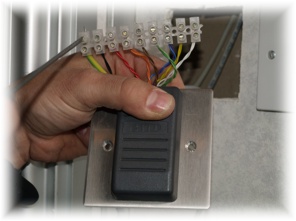
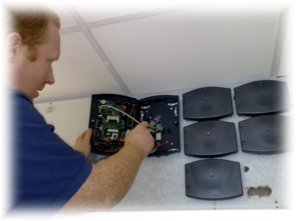
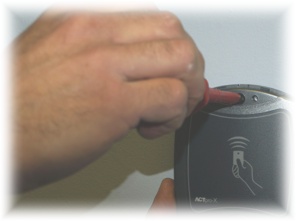
|
| READERS |
| The reader is a means of reading the identity of a person or vehicle wishing to pass through the door or barrier. There are several types of reader. |
| Personal Identifier Code (known as the PIN technique) Keypad |
| This is a keypad requiring a number to be keyed in to identify the person requesting authority to pass through the door or barrier. Such keypads are manufactured by ACT, Bewator, Paxton, Impro |
| This system can be incorporated with the controller as a single unit. |
| Swipe card reader |
| With this technique a card with a magnetic stripe, like a credit card known as a magstripe, is used by swiping through a reader. Variants of the cards are magnetic watermark cards and Wiegand cards. |
| Proximity Reader |
| With this technique either a card or fob can be presented to the reader without touching the reader. |
| Cards may be printed on either side, for example the photo of the holder for further identification. Cards may be Mifare cards which have the capacity to hold further information for other systems such as library use or point of sale information at a food dispenser. |
| Active Reader |
| Where it is not convenient to reach the reader, such as from a vehicle, the fob may be active which means it has its own power source which allows it to transmit greater distances to be read by the reader. |
| Personal Characteristic Systems (Biometric Systems) |
| These readers are based on physiological characteristics such as retina recognition by retinal scanning, finger print or palm print identification, hand recognition measuring the geometry of the hand by measuring between the knuckles. |
|
|
|
| CONTROLLERS |
| The controller allows programming of the system to offer rights to cards/fobs. On basic systems they stand alone or they may be connected to a computer where a number of systems may be controlled from one central location. |
| Anti-passback |
| Where the system recognizes that the means of identification has been already recorded and the token/card is re-presented through the same direction. |
| Forced Entry |
| Where the system recognises that the door has been forced. |
| Door Open |
| The system notes that a door has been left open and flags a warning to the security staff. |
|
| LOCKS |
| There are many locking systems depending on the level of security required, the structure of the door and frame being protected and the cost. |
| In some cases the keep for the latch is controlled, in others the bolt of the lock is powered or a magnetic lock may be used. |
| Locks may be manufactured by Adams Rite, Trimec. |
|
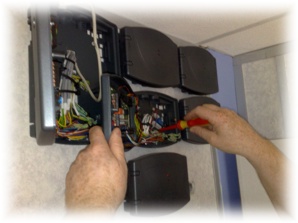
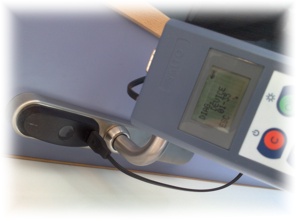
|
|
|
| Both Door Entry and Access control systems can be combined so that visitors are vetted by the person being visited and occupants can present their identity automatically releasing the door. |
| Where there is a fire alarm and the door being controlled is a fire door, the fire alarm is integrated with the fire alarm to automatically release the door when the fire alarm is activated. |
|
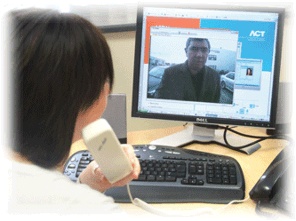
|
|
|
|